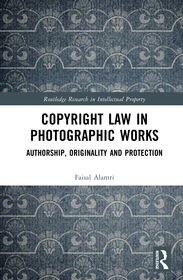
Copyright Law in Photographic Works
Authorship, Originality, and Protection
Sorozatcím: Routledge Research in Intellectual Property;
-
10% KEDVEZMÉNY?
- A kedvezmény csak az 'Értesítés a kedvenc témákról' hírlevelünk címzettjeinek rendeléseire érvényes.
- Kiadói listaár GBP 145.00
-
69 273 Ft (65 975 Ft + 5% áfa)
Az ár azért becsült, mert a rendelés pillanatában nem lehet pontosan tudni, hogy a beérkezéskor milyen lesz a forint árfolyama az adott termék eredeti devizájához képest. Ha a forint romlana, kissé többet, ha javulna, kissé kevesebbet kell majd fizetnie.
- Kedvezmény(ek) 10% (cc. 6 927 Ft off)
- Kedvezményes ár 62 346 Ft (59 378 Ft + 5% áfa)
Iratkozzon fel most és részesüljön kedvezőbb árainkból!
Feliratkozom
69 273 Ft

Beszerezhetőség
Becsült beszerzési idő: A Prosperónál jelenleg nincsen raktáron, de a kiadónál igen. Beszerzés kb. 3-5 hét..
A Prosperónál jelenleg nincsen raktáron.
Why don't you give exact delivery time?
A beszerzés időigényét az eddigi tapasztalatokra alapozva adjuk meg. Azért becsült, mert a terméket külföldről hozzuk be, így a kiadó kiszolgálásának pillanatnyi gyorsaságától is függ. A megadottnál gyorsabb és lassabb szállítás is elképzelhető, de mindent megteszünk, hogy Ön a lehető leghamarabb jusson hozzá a termékhez.
A termék adatai:
- Kiadás sorszáma 1
- Kiadó Routledge
- Megjelenés dátuma 2025. július 25.
- ISBN 9781032952635
- Kötéstípus Keménykötés
- Terjedelem288 oldal
- Méret 234x156 mm
- Súly 690 g
- Nyelv angol
- Illusztrációk 7 Illustrations, black & white; 5 Halftones, black & white; 2 Line drawings, black & white 791
Kategóriák
Rövid leírás:
This book presents an original theory of copyright authorship tailored for photographic works, grounded in the concepts of categorical intention, channeled selection, and causation. It will be of interest to researchers in copyright law and intellectual property law.
TöbbHosszú leírás:
This book presents an original theory of copyright authorship tailored for photographic works, grounded in the concepts of categorical intention, channelled selection, and causation. By addressing the unique dual nature of photography, where mechanical processes intersect with creative choices, it offers a fresh perspective on a longstanding legal challenge.
Through a critical examination of select case law with a focus on Anglo-American law, the book highlights the complexities and inconsistencies in the current copyright protection for photographs due to their dual nature, which exhibits both mechanical and creative characteristics. It argues for moving beyond the conventional one-size-fits-all approach for copyright concepts in favour of adopting a tailored, contextual approach that acknowledges the nature and characteristics of the category of work in question. The book also alludes to emerging technologies such as artificial intelligence and machine learning models, considering their implications for copyright and creative expression. It also discusses how the history of copyright protection of photographic works may illuminate the path towards dealing with conflicts between copyright and perceived mechanical mediums of creative expression.
This book will be of interest to researchers in copyright law and intellectual property law, especially those engaged with the legal treatment of mechanically produced creative works. It offers valuable insights into the evolving relationship between law, technology, and authorship in the digital age.
TöbbTartalomjegyzék:
1. Introduction
2. The Berne Convention for the Protection of Literary and Artistic Works and Photographic Works
3. The United Kingdom and Photographs
4. The United States of America and Photographs
5. Authorship and Photographs
6. The Concept of Originality
7. Originality and Copyright Protection in Photographs in Anglo-American Copyright Law
8. The Impact of the Digital Age on Photography and Copyright
9. The Way Forward for Photographic Copyright? A Focus on Copyright Authorship
10. An Original Two-Tier System for Copyright in Photographic Works
11. Conclusion
Több





